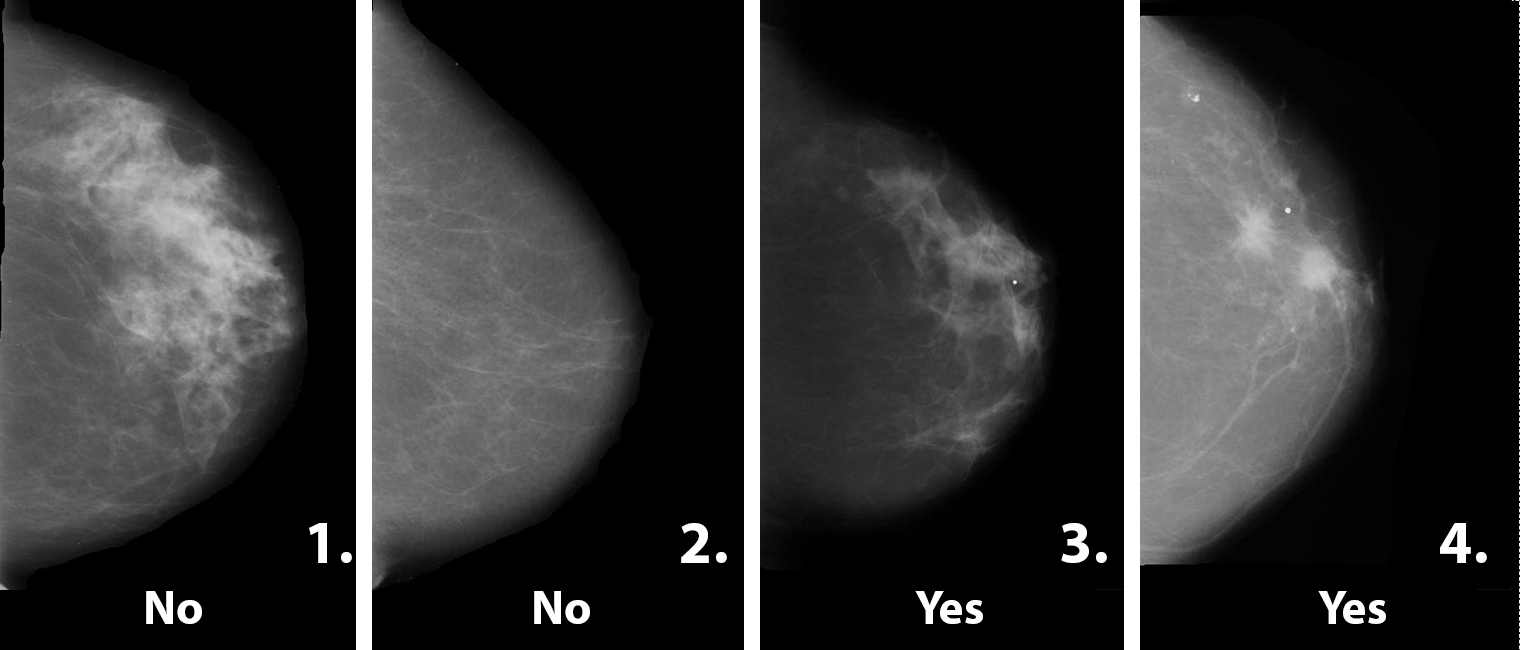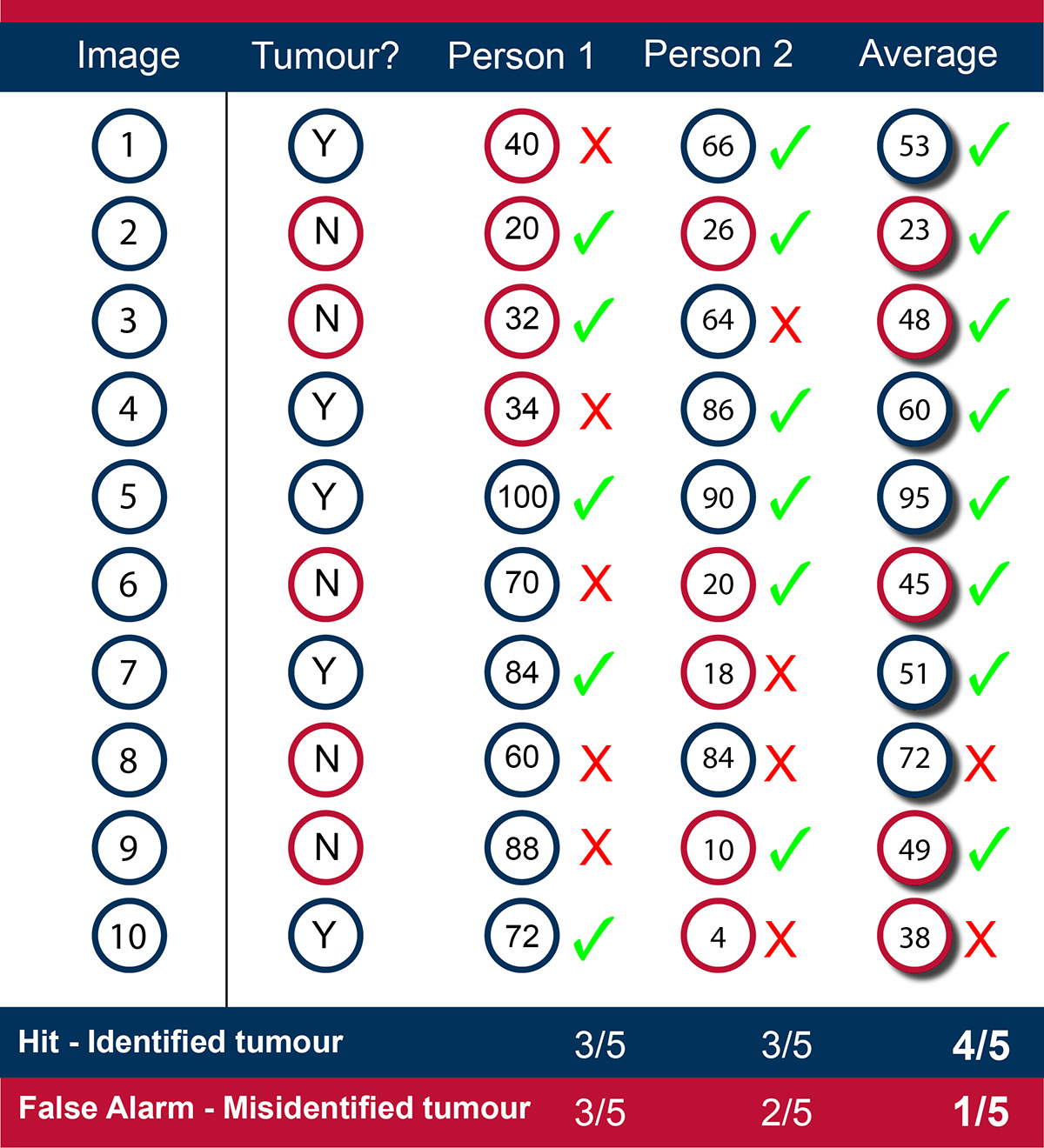The detection rate of weapons moving through airports and tumours growing in the human body can be significantly improved by having two people independently checking scans, a new study has found.
Researchers from Brunel University London found that having two people independently screening baggage scans was over 25% more effective at discovering banned contraband than current practice – having one person check two separate scans of the same bag.
Its hoped the study, ‘It’s not a tumour’: A framework for capitalising on individual diversity to boost target detection , published in the journal Psychological Science, could make ‘trained observers’ – for instance, those working in airport security, radiology and military reconnaissance – better at detecting the rare items they’re looking for.
Can you tell which of these mammograms shows a tumour?
Four mammograms will be shown for 500ms each. After each image, decide whether you think there may be a tumour present.
From 0 to 100 (excluding 50), how likely is it that a tumour was present?

Once you’ve seen all four mammograms, round your scores to 0 (no) or 100 (yes), based on whether your score was above or below 50. (Correct answers below)
When you have your four scores, ask a friend to complete the same test.
The researchers discovered that by averaging both peoples’ scores before rounding up or down, you significantly increase your chance of correctly identifying the tumour.
“There is a known problem with detecting rare targets,” said Dr Jennifer E Corbett, an honorary lecturer for Brunel’s College of Health and Life Sciences.
“When you go to the airport, they always seem to find the bottle of water in your bag – it’s a very common item, so people have a mental template. They’ll just find it. But with rare targets like weapons and guns, people see these far less frequently, so are more likely to miss them."
Dr Corbett, who co-authored the paper alongside Brunel’s Dr Jaap Munneke, says the problem lies with the human visual system, which is only capable of processing a few objects in detail at any given moment. The brain averages out redundant and specific information, filling in the spaces based on prior knowledge. As a result, infrequent objects – those that the observers aren’t expecting to see – are often missed.
However, two people independently looking at the same scan perceive it differently, significantly increasing the possibility of infrequent items being spotted.
“We found that when we pair the estimates of two people who don’t know they’re working together – they have no interaction whatsoever – there is a huge improvement in detection, just by capitalising on the diversity of people’s judgements,” said Dr Corbett.
Answers: Was there a tumour present?

To test their ideas, the researchers conducted two experiments – one which challenged participants to undertake airport screening, and the other mammogram screening.
In the airport screening experiment, 16 participants – non-professionals – were shown an image with nine objects for half a second, and then asked to indicate whether they’d like to call the image back, based on whether they detected a target object.
“The experiment tested weapons detection as well as simple detection tasks,” said Dr Corbett.
“We found that not only did pairing observers estimates improve detection in both types of tasks, but that pairing individuals estimates from the simple task in a way that maximized the decorrelated patterns actually improved the performance in the separate weapons task.”
The researchers discovered that when they paired the detections of two people who worked individually and independently, they not only saw an increase in the detection of rare objects, but also a reduction in the likelihood of harmless items being wrongly flagged as suspicious.
For the second experiment, 18 participants were taught how to identify a tumour on a mammogram, before being shown 400 unique scans where 5% had a tumour present, and then another 400 where 50% had a tumour present.
In both cases, a significant increase in detection rate was observed when two individuals’ results were averaged.

The researchers showed that averaging the results of two independent observers not only increased the likelihood that a tumour would be identified, but that it also decreases the likelihood of false alarms – tumours being identified where none are present.
“The task is not so different between an airport scanner and a radiologist – the idea is you’re looking for something you have knowledge of but see infrequently,” said Dr Corbett.
“It doesn’t matter though whether it’s a tumour or a weapon or something else, averaging two different perceptions of the same scene increases detection.”
The researchers say their detection method is a marked improvement over those currently used in airport and radiological screening, as it significantly reduces the time someone needs to look at a scan.
“The method we propose is probably the best candidate for maximizing the resources of a limited pool of highly trained experts needing to detect rare targets in a lot of images,” said Dr Corbett.
“Obviously the limit here is that it requires a second set of eyes, but we’re now looking for ways to use a deep-learning algorithm to cover the aspects of the images which are causing these decorrelations. We can then pair a single person with the algorithm.”
Reported by:
Tim Pilgrim,
Media Relations
+44 (0)1895 265965
tim.pilgrim@brunel.ac.uk